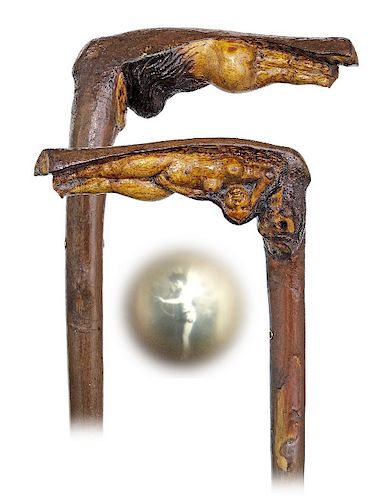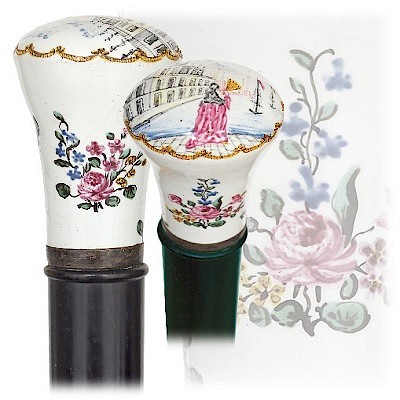46. Erotic Folk Art Stanhope Cane -Ca. 1900 -Fashioned of a natural branch with an integral handle grown at an angle and carved to depict a reclined n
Lot 46
About Seller
Kimball Sterling
125 West Market Street
Johnson City, TN 37604
United States
Family-owned and family-run Johnson City Tennessee auction business for 25 years. Selling antiques and collectables for 38 years. Kimball M. Sterling, Inc. was founded and is owned by Kimball and Victoria Sterling, time and again, they have laid solid claim to world-wide attention and renown with an...Read more
Categories
Estimate:
$1,200 - $1,800
Absentee vs Live bid
Two ways to bid:
- Leave a max absentee bid and the platform will bid on your behalf up to your maximum bid during the live auction.
- Bid live during the auction and your bids will be submitted real-time to the auctioneer.
Bid Increments
| Price | Bid Increment |
|---|---|
| $0 | $10 |
| $100 | $25 |
| $500 | $50 |
| $1,000 | $100 |
About Auction
By Kimball Sterling
Dec 8, 2018
Set Reminder
2018-12-08 11:00:00
2018-12-08 11:00:00
America/New_York
Bidsquare
Bidsquare : Antique Canes and Walking Sticks
https://www.bidsquare.com/auctions/kimball-sterling/antique-canes-and-walking-sticks-3643
A collection of 200 canes and walking sticks. Many different categories are presented in this single owner European collection Kimball Sterling kimballsterling@earthlink.net
A collection of 200 canes and walking sticks. Many different categories are presented in this single owner European collection Kimball Sterling kimballsterling@earthlink.net
- Lot Description
46. Erotic Folk Art Stanhope Cane -Ca. 1900 -Fashioned of a natural branch with an integral handle grown at an angle and carved to depict a reclined nude presented upside down. The beauty is rendered naturalistically with long hair highlighted with dark color and fits astoundingly well in the hand. So far, so good, however, what makes this cane singular is that it is fitted with an erotic Stanhope in a peephole on the top of the shaft. The micro lens shows a standing nude girl with arrow and bow and endows it with a double erotic function as well as the crossover appeal of associating with more than one collecting field to augment its desirability. The expert opinions are unanimous on the French origin and suggest that the cane was probably commissioned by an eccentric Gentleman from the Belle Époque for his own pleasure. The tasteful and inconspicuous look allowed him to wear his cane at all occasions, and, in the appropriate time, makes sensation and become the topic of the gathering. The cane aged well with a desirable glazed surface and still retains its initial metal ferrule. -H. 5 ¼” x 2 ½”, O.L. 34 ¾” -$1,200-$1,800 -The Stanhope, named after English scientist Lord Stanhope (1753-1816), was an optical novelty that was concealed in nineteenth century jewelry, ornaments and occasionally canes. It consisted of a slim glass rod, less than one-eighth of an inch in diameter, which had one end rounded to form a lens and a tiny round collodion positive photograph cemented to the other end. A small hole was drilled in the jewelry, the Stanhope inserted, and a magnified view of the photograph could then be seen by looking through the lens. Actually the Stanhope is the beginning of micro-photography or the microfilm of today. In 1867 a French patent was obtained by Antoine Rochard for objects fitted with Stanhope’s. -For a cane with Stanhope’s see C. Dike, Cane Curiosa, Chapter 10, Photography, page 114, 10/24 and Francis H. Monek’s book, Canes Through The Ages, page 262.
- Shipping Info
-
Each auction has different shipping terms but the buyer always pays.Canes:After payment has been received we will ship in-house the domestic orders, International bidders will be shipped by the UPS store (423-979-7122) and email store4146@theupsstore.com After we receive payment we will deliver to the UPS store and they will contact you.Other Auctions:After payment has been received and cleared we will deliver your items to the UPS Store and they will quote and prepare for shipping.phone (423-979-7122 and email store4146@theupsstore.com
-
- Buyer's Premium



 EUR
EUR CAD
CAD AUD
AUD GBP
GBP MXN
MXN HKD
HKD CNY
CNY MYR
MYR SEK
SEK SGD
SGD CHF
CHF THB
THB

















